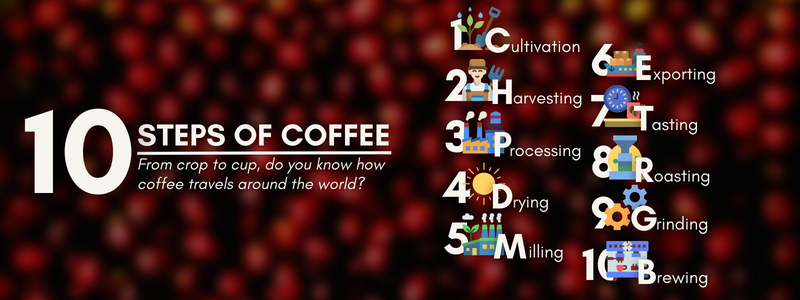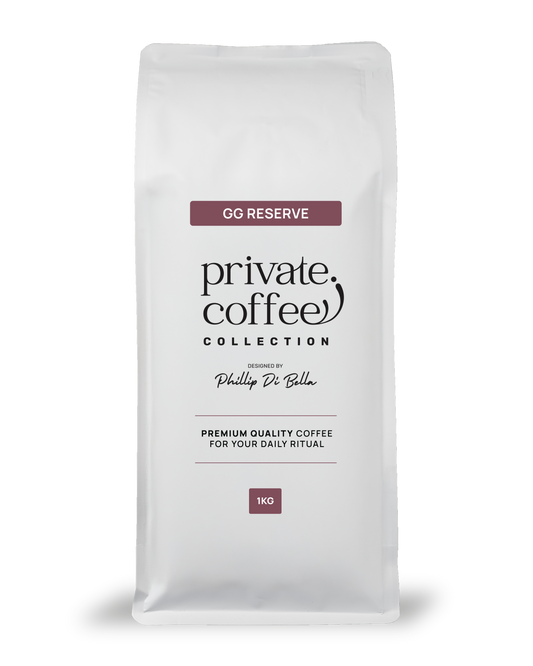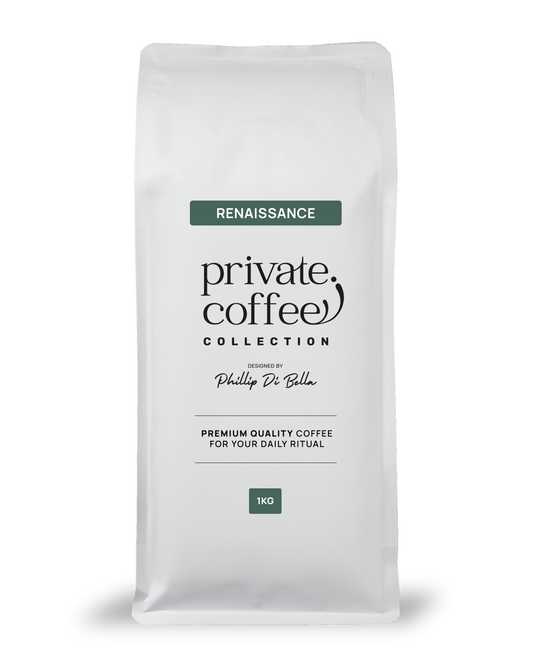Coffee is one of the most widely consumed beverages in the world, with millions of people starting their day with a steaming cup (or two!). But have you ever wondered about the journey a coffee bean takes before it ends up in your mug?
In this blog post, we take a closer look at all the steps involved in getting your morning cup of coffee.

1. Planting/Cultivation
Across the globe, approximately 10 million tons of coffee is grown each year. There are over 100 known species of coffee, but only 2 are cultivated on a large scale – Arabica and Robusta. Arabica is generally the sweeter, better tasting species due to its higher flavour potential and makes up just over 60% of global production. Robusta makes up the rest, much of it going towards the production of instant coffee. It takes 3-4 years for trees to bear fruit, and around 7 years to be fully grown. The trees produce cherry like fruit, within it is the seed that’s used to make coffee
At the cultivation stage, the grower will be selecting varieties of coffee with specific characteristics such as the height of the trees, yield, resistance to disease, insect infestation, and cup quality.
Getting these characteristics right will help at the harvesting and processing stage, ensuring the process is much more efficient.
2. Harvesting
When ripe, coffee cherries will be a bright red – but it’s not uncommon to also see yellow and purple cherries. Depending on the terrain and the cost of labor, coffee will either be handpicked or harvested by machine. Machine harvesting uses either handheld or large driven machines to shake ripe cherries off the tree, with those that fall taken for further sorting and processing.
There are two methods for hand picking cherries: strip picking and selective picking. In strip picking, the picker removes all cherries from the branch, regardless of their ripeness. On the other hand, selective picking involves picking only the ripest cherries – as the pickers move among the trees over a period of days or weeks, picking them as they ripen.
An efficient picker can harvest 50-100kg of cherries per day – but the yield after processing is only about 10-20kg.
3. Processing
Processing can be broken down into 3 main methods that relate to taking off or leaving certain layers on the coffee seed before drying: Natural, Honey or Pulped Natural, and Washed.
–Natural: In this process the coffee cherry will remain intact. After sorting out defective cherries, they are sent straight to drying, it isn’t always this straight forward as producers may employ fermentation methods to alter the coffee flavour profile.
–Honey/Pulped Natural: Although Honey processing and Pulped Natural are considered different processes, they are closely related. It involves pulping the coffee cherry but leaving the mucilage, the gelatinous pectin and sugar rich, layer intact. Variation in how water is used in the process and if the producer chooses to add a fermentation stage can greatly affect the flavour profile of the final product.
–Washed: Washed process also pulps the coffee cherry but instead of leaving the mucilage intact, the seeds are fermented to break down the pectin over 8-48 hours and then rinsed, leaving just the seed and parchment layer that protects the seed.
These 3 methods represent coffee cherry processing at its most simplified, however within each of these there is a multitude of variations. This includes how much water in the process is used, how it is recycled, how long the cherries are fermented, and the types of fermentation they use. These variations have made a market for producers to experiment and innovate. Anaerobic fermentation, carbonic maceration and yeast fermentation are just a few recent innovations that producers are exploring to add more value to their product in the supply chain and showcase what they have to offer.
4. Drying
After coffee beans have been processed, they are typically dried using one of two methods: on a patio/raised drying bed, or in a drying machine.
The main objective of the drying process is to reduce the moisture content of the coffee beans from approximately 50% after processing, to between 10-12%. This is a crucial step in coffee production, as the moisture level affects the quality and shelf life of the coffee. By carefully controlling the drying process, coffee producers can ensure that their beans are of the highest quality.
5. Milling
Once the coffee is dry, it undergoes hulling – which involves removing the dried cherry or parchment layer to expose the seed. The seed is then polished to remove the thin papery layer, known as the silver skin. In addition to these steps, beans can be sorted based on their size and density.
This grading process is essential as it can determine the coffee’s price per pound. By segregating the beans based on their size and density, coffee roasters can create a consistent roast, enhancing the coffee’s flavor and aroma.
6. Exporting
Coffee beans are then bagged for storage and transportation. The standard bag size for coffee is 60kg – although in some regions like Central and South America, bags weighing 69-70kg are also used. High-quality beans are usually packed in plastic grainpro bags – which provide an airtight and moisture-proof environment to keep the beans fresh for longer periods.
Green coffee beans can be stored for up to a year before the quality starts to deteriorate. During this period, there will be some natural flavor variation that a coffee roaster must take into consideration when blending and roasting.
Storing green coffee beans properly is crucial to maintaining their quality. They should be kept in a cool, dry, and well-ventilated area, away from direct sunlight, heat, and moisture.
7. Tasting
Quality control tasting will happen across the whole supply chain, using a method called cupping – the standardised method for tasting coffee. Light roasted coffee is coarsely ground and placed in a cup, covered in hot water. A crust of coffee will then form, and be broken by a spoon. Whatever is remaining on the top will be scooped off, with tasters then using a spoon to slurp the coffee in the cup.
Tasters are looking for flaws and characteristics to analyse the quality of the coffee. Each person in the supply chain may often have different areas they focus on when analysing. Producers and exporters may be focused on what the defects are and how to reduce them, whilst importers and roasters are looking for value for money and marketable characteristics.
8. Roasting
Roasting is essentially cooking the green coffee in a process called pyrolysis. This process uses extreme heat to break down sugar, protein, starch, and aromatic compounds to create new flavours and aromas. As all coffees are processed differently, each coffee needs to be treated differently in the roaster using roast profiles – where the heat application to the bean is managed for repeatable results for flavour preferences.
You can learn more about the coffee roasting process from our onsite roasting partner, Coffee Alliance, in their recent coffee roasting blog.
9. Grinding
The grinding process involves breaking down the roasted beans into smaller, uniform particles. The preferred method of grinding coffee is using burr grinders, which allow for consistency and uniform grind size – ensuring even extraction and maximises the flavor potential of each coffee.
Once this process has been completed, the coffee is labeled as ‘ground’. Different brewing methods require different grind sizes, which can range from fine (for espresso) to coarse (for French press). Once ground, the coffee is ready to be brewed using various methods such as pour-over, drip, or espresso machines.
10. Brewing
The brewing process of coffee involves pouring hot water over ground coffee beans to extract the soluble compounds and flavors, creating a brewed coffee beverage. The brewing process includes several factors, such as water temperature, brew time, coffee-to-water ratio, and grind size.
There are many different types of brewed coffee, some of which include: Drip coffee, French press, Espresso, Aeropress, Pour-over, Turkish coffee, and Cold brew. The brewing process should be carefully controlled to ensure that the coffee has the right balance of flavors, acidity, body, and aroma.
——————
The journey of a coffee bean is a complex and detailed process. Each step is critical in producing high-quality coffee, all of which determines the taste, quality, and price of the coffee. By understanding the steps involved in coffee production, coffee drinkers can gain a deeper appreciation of the rich and flavorful beverage in their cup.
Interested in being part of this exciting process?
At The Coffee Commune, our membership program is a powerful resource helping members navigate through today’s challenging business climate; a genuine collaboration to accelerate your business success and profitability. Membership is open to anyone involved within the hospitality industry including café and restaurant proprietors, retailers, suppliers of goods and services, roasters, baristas, and enthusiasts.
Contact our team at The Coffee Commune and discover how your business could be involved.






